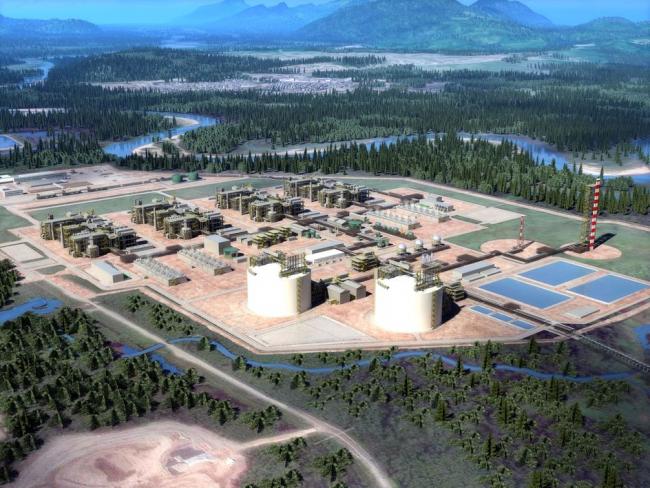Articles Menu

(Nov 25, 2021) - LNG exports will doom B.C.’s emissions reduction goals
Meeting the Roadmap’s targets with the
LNG Canada project would mean even more drastic cuts to the non-oil and gas
sector, along with controversial, costly and energy-intensive carbon
capture and storage technologies.
When the provincial government announced its CleanBC Roadmap to 2030 on
Oct. 25, conspicuously absent was any mention of B.C.’s LNG export
aspirations, which will increase emissions from the oil and gas sector and
likely doom any chance of meeting B.C.’s emissions reduction targets.
The LNG Canada project under construction in Kitimat includes a gas-fired
liquefaction terminal with two trains (LNG liquefaction and purification
facilities) slated for completion in 2025 and two additional trains to be
completed by 2030. The Canada Energy Regulator’s most conservative forecast
<https://apps.cer-rec.gc.ca/
projects
that B.C. gas production will have to increase 38 per cent to meet the feed
gas requirements of the first phase and 76 per cent when the second phase
is complete.
Increasing gas production in 2025 for the LNG Canada project will add
substantial new emissions to the existing oil and gas sector, which were
not addressed in the CleanBC Roadmap. The terminal itself will add nearly
four million tonnes per year and, together with producing the input gas it
requires, the sector’s emissions will increase 92 per cent when phase 1 is
complete and 130 per cent when phase 2 comes online.
Instead of reducing oil and gas emissions from 2007 levels, LNG Canada will
increase the sector’s emissions by 24 per cent in 2030, 54 per cent in 2040
and 49 per cent in 2050.
With LNG Canada, even if all other sectors of B.C.’s economy met the
CleanBC Roadmap targets, total emissions would nevertheless miss B.C.’s
climate targets by a long shot (emissions would be down only 29 per cent in
2030, 41 per cent in 2040, and 58 per cent in 2050, instead of the required
40, 60 and 80 per cent, respectively). In 2050, the 16.5 million tonnes of
emissions from the oil and gas sector alone would exceed B.C.’s total
allowable carbon budget of 13.2 million tonnes.
Meeting the Roadmap’s targets with the LNG Canada project would mean even
more drastic cuts to the non-oil and gas sector, along with controversial,
costly and energy intensive carbon capture and storage technologies.
The John Horgan government justifies LNG exports by claiming that global
emissions will be reduced by displacing coal-burning in places like China.
In fact, due to the much higher climate impact of methane in the early
years after release compared to carbon dioxide, LNG powered plants in China
would have higher emissions than coal over their first few decades of life.
The CleanBC Roadmap pledges to reduce methane emissions from the production
of gas 75 per cent by 2030 without stating how this could be done. If it
was easy, companies would have done it long ago as lost methane means lost
revenue. Government emissions reduction ambitions have a history of
failure: B.C.’s 2008 climate action plan, for example, stated emissions
would be down 33 per cent from 2007 levels by 2020 — instead they are up
four per cent — and B.C. emissions are up six per cent since the Paris
Agreement was signed in 2016.
Government claims of a revenue bonanza from LNG exports are also
contradicted by the hundreds of millions it provided as incentives for LNG
and industry as well as the decline in government revenues from royalties
and taxes over the past two decades despite increased production.
Canada is a mature exploration region and gas production is falling in
every province but B.C., where the advent of fracking has provided a
temporary reprieve. B.C. has most of what is left of Canada’s low-cost gas,
and what remains would best be used to fill our domestic energy needs,
beyond what renewables are able to provide, over the next few decades. Gas
can provide a valuable backup for intermittent renewables like wind and
solar, as well as a source of high-grade heat; exporting it as fast as
possible for questionable climate benefits makes no sense.
It’s not surprising that LNG isn’t even mentioned in B.C.’s CleanBC Roadmap
to 2030 given its impact on the province’s emissions reduction targets.
Canadians deserve viable strategies that provide long-term energy and
climate security — not ill-conceived resource extraction projects for
illusory gains represented by LNG exports.
David Hughes is an earth scientist who has worked in the energy industry
for more than 40 years, including 32 years with the Geological Survey of
Canada. He heads Global Sustainability Research and is a research associate
with the Canadian Centre for Policy Alternatives, B.C. Office.
[Above image: An architect's rendering of the LNG Canada natural gas liquefaction
plant now under construction at Kitimat.]